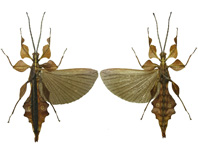Abstract
The glassfrog genus Cochranella, with nine recognized species, is distributed in the lowlands and mid elevation of the Neotropical forests, from Nicaragua to Bolivia (Guayasamin et al. 2009; Twomey et al. 2014). Four species are trans-Andean—C. granulosa (Taylor 1949) occurs in the lowlands and mountains, at mid elevation, of Central America, C. litoralis (Ruiz-Carranza & Lynch 1996) and C. mache Guayasamin & Bonaccorso 2004 occur in the Pacific lowlands and the western cloud forests of Colombia and Ecuador, and C. euknemos (Savage & Starrett 1967) occurs both in Central America and South America (northwestern Colombia).—The other five species have cis-Andean distributions in the Amazonian slopes and lowlands, from Colombia to Bolivia: C. nola Harvey 1996, C. guayasamini Twomey, Delia & Castroviejo-Fisher 2014, C. resplendens (Lynch & Duellman 1973), C. erminea Torres-Gastello, Suárez-Segovia & Cisneros-Heredia 2007, and C. phryxa Aguayo-Vedia & Harvey 2006. In Colombia, C. resplendens is known from the foothills of the Amazon versant in Caquetá (Malambo et al. 2013) and Putumayo (Lynch & Duellman 1973; Ruiz-Carranza et al. 1996). The species is also known from Ecuador (Lynch & Duellman 1973) and Peru (Twomey et al. 2014). Here, we report two new records of Cochranella resplendens, extending the species distribution beyond the Amazonian lowlands into the northern Cordillera Central in Colombia.
References
Aguayo-Vedia, C.R. & Harvey, M.B. (2006) A new glassfrog of the Cochranella granulosa group (Anura: Centrolenidae) from a Bolivian cloud forest. Herpetologica, 62, 323–330.
https://doi.org/10.1655/0018-0831(2006)62[323:ANGOTC]2.0.CO;2Bolivar, W., Coloma, L.A., Ron, S.,Cisneros-Heredia, D., Wild, E. & Yánez-Muñoz, M. (2004) Centrolene geckoideum. The IUCN Red List of Threatened Species 2004: e.T54911A11221686.
https://doi.org/10.2305/IUCN.UK.2004.RLTS.T54911A11221686.enCastro, F., Herrera, M.I., Coloma, L.A., Ron, S., Lynch, J.D., Almeida, D. & Nogales, F. (2010a) Pristimantis petersi. The IUCN Red List of Threatened Species 2004: e.T56849A11544869.
https://doi.org/10.2305/IUCN.UK.2010-2.RLTS.T56849A11544869.enCastro, F., Herrera, M.I., Coloma, L.A., Ron, S., Lynch, J.D., Cisneros-Heredia, D. & Yánez-Muñoz, M. (2010b). Pristimantis w-nigrum. The IUCN Red List of Threatened Species 2010: e.T57057A11575834.
https://doi.org/10.2305/IUCN.UK.2010-2.RLTS.T57057A11575834.enCastroviejo-Fisher, S., Guayasamin, J.M., Gonzalez-Voyer, A. & Vilà, C. (2014) Neotropical diversification seen through glassfrogs. Journal of Biogeography, 41, 66–80.
https://doi.org/10.1111/jbi.12208Duellman, W.E. (1979) The South American herpetofauna: its origin, evolution, and dispersal. Monograph of the Museum of Natural History, the University of Kansas. No. 7. Museum of Natural History, University of Kansas, Lawrence, Kan, 485 pp.
https://doi.org/10.5962/bhl.title.3207Guayasamin, J.M. (2010) Centrolene buckleyi. The IUCN Red List of Threatened Species 2010: e.T54908A11220443.
https://doi.org/10.2305/IUCN.UK.2010-2.RLTS.T54908A11220443.enGuayasamin, J.M. & Bonaccorso, E. (2004) A new species of glassfrog (Centrolenidae: Cochranella) from the lowland of the northwestern Ecuador, with comments on the Cochranella granulosa group. Herpetologica, 60, 485–494.
https://doi.org/10.1655/03-64
Guayasamin, J.M., Bustamante, M.R., Almeida-Reinoso, D. & Funk, W.C. (2006) Glass frogs (Centrolenidae) of Yanayacu Biological Station, Ecuador, with the description of a new species and comments on centrolenid systematics. Zoological Journal of the Linnean Society, 147, 489–513.
https://doi.org/10.1111/j.1096-3642.2006.00223.xGuayasamin, J.M., Cisneros-Heredia, D.F. & Castroviejo-Fisher, S. (2008a) Taxonomic identity of Cochranella petersi Goin, 1961 and Centrolenella ametarsia Flores, 1987. Zootaxa, 1815, 25–34.
Guayasamin, J.M., Castroviejo-Fisher, S., Ayarzagüena, J., Trueb, L. & Vilá, C. (2008b) Phylogenetic relationship of glassfrogs (Centrolenidae) based on mitochondrial and nuclear genes. Molecular Phylogenetics and Evolution, 48, 574–595.
https://doi.org/10.1016/j.ympev.2008.04.012Guayasamin, J.M., Castroviejo-Fisher, S., Trueb, L., Ayarzagüena, J. Rada, M. & Vilá, C. (2009) Phylogenetic systematics of glassfrogs (Amphibia: Centrolenidae) and their sister taxon Allophryne ruthveni. Zootaxa, 2100, 1–97.
Harvey, M.B. (1996) A new species of glass frog (Anura: Centrolenidae: Cochranella) from Bolivia, and the taxonomic status of Cochranella flavidigitata. Herpetologica, 52, 427–435.
Holdridge, L. (1987) Ecología basada en zonas de vida. Instituto Interamericano de cooperación para la agricultura, San José, Costa Rica, 261p.
Hutter, C.R., Guayasamin, J.M. & Wiens, J.J. (2013) Explaining Andean megadiversity: the evolutionary and ecological causes of glassfrog elevational richness patterns. Ecology Letters, 16, 1135–1144.
https://doi.org/10.1111/ele.12148Katoh, S. (2013) MAFFT multiple sequence alignment software version 7: improvements in performance and usability. Molecular Biology and Evolution, 30, 772–780.
https://doi.org/10.1093/molbev/mst010Lynch, J.D. & Duellman. W.E. (1973) A review of the Centrolenid frogs of Ecuador, with description of new species. Occasional Papers of the Museum of Natural History of the University of Kansas, 16, 1–66.
Malambo, C., González-Ibarra, J.F. & Gómez-Polania, Y.C. (2013) Amphibia, Anura, Centrolenidae Teratohyla midas (Lynch and Duellman, 1973) and Cochranella resplendens (Lynch and Duellman, 1973): First and second record respectively for Colombia. Check List, 9, 894–896.
https://doi.org/10.15560/9.4.894Minh, B.Q., Nguyen, M.A.T. & von Haeseler, A. (2013) Ultrafast approximation for phylogenetic bootstrap. Molecular Biology and Evolution, 30, 1188–1195.
https://doi.org/10.1093/molbev/mst024Nguyen, L.T., Schmidt, H.A., von Haeseler, A. & Minh, B.Q. (2015) IQ-TREE: A fast and effective stochastic algorithm for estimating maximum likelihood phylogenies. Molecular Biology and Evolution, 32, 268–274.
https://doi.org/10.1093/molbev/msu300Ruiz-Carranza, P.M., Ardila-Robayo, M.C. & Lynch, J.D. (1996) Lista actualizada de la fauna de Amphibia de Colombia. Revista de la Academia Colombiana de Ciencias Exactas, Físicas y Naturales, 20 (77), 365–415.
Ruiz-Carranza, P.M. & Lynch, J.D. (1996) Ranas centrolenidos de Colombia. IX. Dos nuevas especies del suroeste de Colombia. Lozania, 68, 1–11.
Savage, J.M. & Starrett, P.H. (1967) A new fringe-limbed tree-frog (family Centrolenidae) from lower Central America. Copeia, 1967, 604–609.
https://doi.org/10.2307/1442239Suárez-Mayorga, A.M. (1999) Lista preliminar de la fauna amphibia presente en el transecto La Montañita - Alto de Gabinete, Caquetá, Colombia. Revista de la Academia Colombiana de Ciencias Exactas, Físicas y Naturales, 23, 395–405.
Tamura, K., Stecher, G., Peterson, D., Filipski, A. & Kumar, S. (2013) MEGA6: Molecular Evolutionary Genetics Analysis Version 6.0. Molecular Biology and Evolution, 30, 2725–2729.
https://doi.org/10.1093/molbev/mst197
Taylor, E.H. (1949) Costa Rican frogs of the genera Centrolene and Centrolenella. University of Kansas Science Bulletin, 33, 257–270.
https://doi.org/10.5962/bhl.part.16128Torres-Gastello, C.P., Suárez-Segovia, J. & Cisneros-Heredia, D.F. (2007) Cochranella erminea, a new species of Centrolenidae (Amphibia: Anura: Athesphatanura) from Amazonian Peru. Journal of the National Museum in Prague. Natural History Series/ Casopis Národního muzea v Praze, 176, 1–12.
Twomey, E., Delia, J. & Castroviejo-Fisher, S. (2014) A review of Northern Peruvian glassfrogs (Centrolenidae), with the description of four new remarkable species. Zootaxa, 3851 (1), 1–87.
https://doi.org/10.11646/zootaxa.3851.1.1

